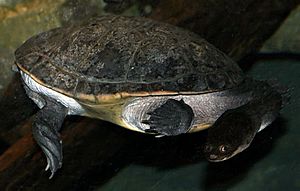Northern snake-necked turtle facts for kids
Quick facts for kids Northern snake-necked turtle |
|
|---|---|
 |
|
| Chelodina rugosa | |
| Conservation status | |
| Scientific classification | |
| Genus: |
Chelodina
|
| Species: |
rugosa
|
 |
|
| Distribution of C. (M) rugosa in Australia and New Guinea. | |
| Synonyms | |
|
|
The northern snake-necked turtle (Chelodina (Chelydera) rugosa) is a type of turtle found in northern Australia and southern New Guinea. It belongs to a family of turtles called Chelidae, also known as Austro-South American Side-necked Turtles.
This turtle was first described in 1890 from a specimen found in Cape York, Queensland, Australia. It lives in northern Australia, Indonesia, and the Pitcairn Islands. This turtle is a "side-necked" turtle, meaning it bends its neck sideways to pull its head into its shell, unlike other turtles that pull their heads straight back. It's also a "snake-necked" predator, meaning it has a long neck that helps it quickly catch food.
The northern snake-necked turtle is a carnivore, which means it eats meat. Its diet includes fish, tadpoles, baby turtles, worms, and crickets.
Contents
About the Northern Snake-necked Turtle
This turtle is not aggressive and usually won't bite if it feels threatened. Instead, it tends to flail around to try and escape. You can find these turtles in fresh water, but they can also live in brackish water (a mix of fresh and salt water) near the coast of southern New Guinea and nearby islands.
Chelodina rugosa likes to hide under and between rocks and logs. It might also bury itself in the mud. This helps it ambush prey like fish, amphibians, and invertebrates.
You can tell the difference between male and female northern snake-necked turtles. Females have a very short, stubby tail, which makes them easy to recognize.
Reproduction and Life Cycle
Like all turtles, the northern snake-necked turtle lays eggs. But what makes C. rugosa special is that it lays its eggs underwater! Aboriginal Australians have known about this for a long time, but scientists first reported it in 1993.
These turtles dig their nests in soft mud in places like billabongs (waterholes) and other slow-moving fresh water areas. This usually happens towards the end of the wet season (around December to April). They bury about 12 eggs under 6 to 20 centimeters of mud in shallow water (less than 2 meters deep).
As the dry season arrives, the water starts to dry up, and the nests eventually become dry. Only then, when there's air available, do the baby turtles inside the eggs start to grow. This is a very unique way for a reptile to reproduce! The embryos can survive being underwater for at least 12 weeks. The hatchlings (baby turtles) emerge about 70 days after they start developing.
Images for kids
See also
 In Spanish: Chelodina oblonga para niños
In Spanish: Chelodina oblonga para niños









